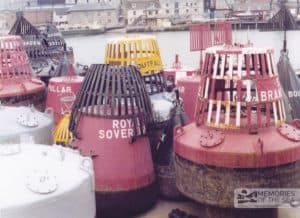Graham Hall on Navigation
The buoys were all driven by acetylene in my day. We used to have acetylene bottles like big CO2 bottles, you know, great big heavy bottles in the buoys, they were accumulators and there was the acetylene was produced in these and it used to go up to a flasher unit on the thing which was a flame that was developed by the Swedes, they were very clever with these things and these flashers used to go and this was one of our main jobs was going round re-lighting these.
There was a little burner in there and puffs of gas used to come out and that’s what gave the buoy it’s character. That’s what gave its light, it was magnified up with a lens and we often were sent out regularly.
It was a point of honour then that if a buoy went out, we sailed immediately, whatever, to go and repair it and that was when I was a Junior Officer, my job you had to jump on the buoy and climb up this thing, bouncing around and then try and re-light the light. We used to get them re-lit in most cases.
Sometimes they’d run out of gas in which case we had to put a temporary bottle on them until the buoy could be picked up by the ship and recharged, but we … I can remember coming all the way from Harwich once to relight the Bridge Buoy.
We’d gone up to Harwich for some reason, to pick up some stuff and the Bridge Buoy was blown out and we had to come all the way down to the Bridge Buoy, which is a big buoy off the entrance to The Channel by the Needles lighthouse there.
We came down there and it was a filthy night. Had to go in there and jump on this buoy and open it up and all it had been, a little bit of charcoal had fallen in the burner and put it out, so we flicked it out and put the match to it. So, we came all that way for a match which was, you know, that’s what happened all the time, that’s how they are.
Now they’re operated electrically; they have batteries and they have solar cells, photovoltaic which recharge the batteries and they are very small, light-weight lights, very effective and that’s technology.
We were living with almost 19th Century technology, early 20th Century technology when we used to look after the gas buoys. They’ve all gone now, they’re all electric.







